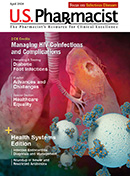US Pharm. 2017;42(12)2.
Oral bacteria in the gut could drive immune-cell induction and inflammatory bowel disease (IBD), such as Crohn’s disease (CD) and ulcerative colitis. In a study published in the online version of Science in October, researchers at Tokyo’s Keio University School of Medicine looked into the relationship between salivary microbes and IBD, reporting potentially game-changing results.
“When the bacterium Klebsiella pneumoniae colonizes in an intestine out of microbial balance, immune cells called T helper 1 (TH1) become overactive in the gut, resulting in intestinal inflammation leading to the onset of IBD,” said Professor Masahira Hattori. During their research, the scientists saw “relatively enriched” levels of oral microbes in gut microbiomes of patients with HIV, colon cancer, and IBD (including CD) when compared with healthy individuals. CD impacts approximately 1.3% of the U.S. population, and the median onset of the disease is age 30 years. Most patients are diagnosed between the ages of 20 and 30 years.
Any research that clarifies the root cause or suggests potential treatment modalities is welcomed. As John A. Galdo, PharmD, BCPS, BCGP, et al, write in this month’s CE article, “Biological Medication Use in Crohn’s Disease,” CD “is an inflammatory disorder that is often treated with biological medications. Unfortunately, the use of biologics is not well defined for the treatment of Crohn’s disease.” Furthermore, as Galdo et al write, “CD does not have a clear step-by-step algorithm compared to other medical conditions like diabetes.”
Perhaps the research revelations coming out of Japan will help chart a treatment course involving biologics.
To arrive at their results, Professor Hattori and colleagues gave salivary samples of healthy and IBD-afflicted individuals, respectively, to germ-free mice. After 6 to 8 weeks, they analyzed the microbial content of the mice’s feces and found some 20 kinds of oral bacteria. In addition, immunological analysis found that the level of TH1 cells, which could indicate an onset of autoimmune diseases when excessive, significantly increased in some of the mice. Moreover, they found that K pneumoniae was a strong inducer of TH1 cells when colonizing in the gut.
A logical conclusion is that having good oral hygiene to eliminate K pneumoniae will help patients stay healthy. Unfortunately, K pneumoniae is multidrug resistant, and there are currently no methods available to specifically kill or remove it.
Despite the recent positive developments, however, treating CD and other types of IBD remains a complex proposition. “Biological agents used in CD require extensive monitoring and administration counseling,” write Galdo et al in this issue’s CE article. These latest research results promise to help plot a clearer path to combating this stubborn gastrointestinal disorder and other IBD-related foes.
To comment on this article, contact editor@uspharmacist.com.





